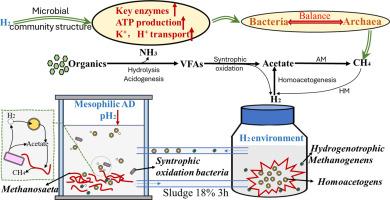当前位置:
X-MOL 学术
›
Water Res.
›
论文详情
Our official English website, www.x-mol.net, welcomes your
feedback! (Note: you will need to create a separate account there.)
Improved anaerobic digestion of food waste under ammonia stress by side-stream hydrogen domestication
Water Research ( IF 11.4 ) Pub Date : 2024-11-08 , DOI: 10.1016/j.watres.2024.122770 Yi Wang, Haoyang Li, Keke Ding, Xueyu Zhao, Miao Liu, Linji Xu, Li Gu, Jinze Li, Lin Li, Qiang He, Jianjun Liang
Water Research ( IF 11.4 ) Pub Date : 2024-11-08 , DOI: 10.1016/j.watres.2024.122770 Yi Wang, Haoyang Li, Keke Ding, Xueyu Zhao, Miao Liu, Linji Xu, Li Gu, Jinze Li, Lin Li, Qiang He, Jianjun Liang

|
High ammonia concentration inhibits archaea's activity, causing the accumulation of H2 and acetate, which suppresses methane production in anaerobic digestion (AD). The study aimed to enhance microbial hydrogen metabolism through a side-stream hydrogen domestication (SHD) strategy, which involves applying hydrogen stimulation to a portion of the sludge separately. SHD maintained a stable methane yield of 407.5 mL/g VS at a high total ammonia nitrogen (TAN) concentration of 3.1 g/L. In contrast, the control group gradually decreased and stopped methane production at a TAN concentration of 2.3 g/L. Further analysis using enzyme activity assays, flow cytometry, and metagenomics explored the mechanisms underlying ammonia tolerance of SHD-treated group. SHD reshaped the microbial community, enriching homoacetogens and Methanosaeta-dominated methanogenic archaea. Key metabolic pathways including homoacetogenesis, butyrate degradation, propionate degradation, and methane production were enhanced. The activity of related enzymes also increased. Gene abundance in energy-generating pathways, such as glycolysis, was enhanced, ensuring adequate ATP production. Additionally, the high gene abundance of ion transport systems contributed to regulating proton imbalance and supplementing intracellular K+. This study provides important insights and practical guidance for developing novel techniques in the field of anaerobic digestion.
中文翻译:

通过侧流氢驯化改善氨胁迫下食物垃圾的厌氧消化
高氨浓度会抑制古细菌的活性,导致 H2 和乙酸盐的积累,从而抑制厌氧消化 (AD) 中甲烷的产生。该研究旨在通过侧流氢驯化 (SHD) 策略增强微生物氢代谢,该策略涉及分别对一部分污泥进行氢刺激。SHD 保持了稳定的甲烷产率,为 407.5 mL/g,而总氨氮 (TAN) 浓度高达 3.1 g/L。相比之下,对照组逐渐减少并在 TAN 浓度为 2.3 g/L 时停止甲烷产生。使用酶活性测定、流式细胞术和宏基因组学进行进一步分析,探讨了 SHD 处理组氨耐受性的潜在机制。SHD 重塑了微生物群落,富集了同乙原和甲烷aeta主导的产甲烷古细菌。包括同源乙酸生成、丁酸盐降解、丙酸盐降解和甲烷产生在内的关键代谢途径得到增强。相关酶的活性也增加。能量产生途径(如糖酵解)中的基因丰度得到增强,确保足够的 ATP 产生。此外,离子转运系统的高基因丰度有助于调节质子失衡和补充细胞内 K+。本研究为厌氧消化领域的新技术开发提供了重要的见解和实践指导。
更新日期:2024-11-08
中文翻译:

通过侧流氢驯化改善氨胁迫下食物垃圾的厌氧消化
高氨浓度会抑制古细菌的活性,导致 H2 和乙酸盐的积累,从而抑制厌氧消化 (AD) 中甲烷的产生。该研究旨在通过侧流氢驯化 (SHD) 策略增强微生物氢代谢,该策略涉及分别对一部分污泥进行氢刺激。SHD 保持了稳定的甲烷产率,为 407.5 mL/g,而总氨氮 (TAN) 浓度高达 3.1 g/L。相比之下,对照组逐渐减少并在 TAN 浓度为 2.3 g/L 时停止甲烷产生。使用酶活性测定、流式细胞术和宏基因组学进行进一步分析,探讨了 SHD 处理组氨耐受性的潜在机制。SHD 重塑了微生物群落,富集了同乙原和甲烷aeta主导的产甲烷古细菌。包括同源乙酸生成、丁酸盐降解、丙酸盐降解和甲烷产生在内的关键代谢途径得到增强。相关酶的活性也增加。能量产生途径(如糖酵解)中的基因丰度得到增强,确保足够的 ATP 产生。此外,离子转运系统的高基因丰度有助于调节质子失衡和补充细胞内 K+。本研究为厌氧消化领域的新技术开发提供了重要的见解和实践指导。


















































 京公网安备 11010802027423号
京公网安备 11010802027423号